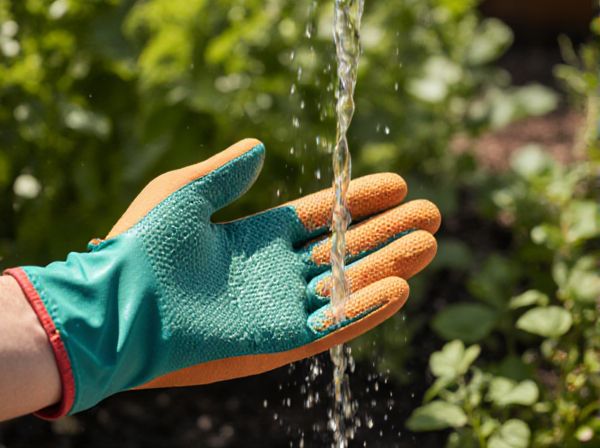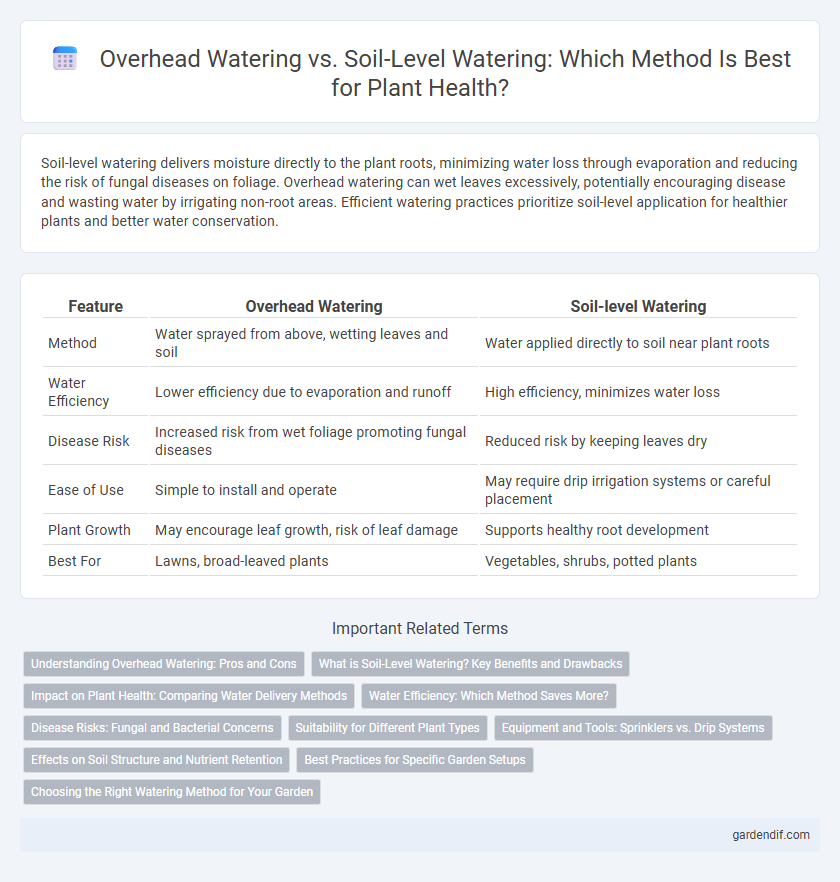
Overhead watering vs Soil-level watering Illustration
Soil-level watering delivers moisture directly to the plant roots, minimizing water loss through evaporation and reducing the risk of fungal diseases on foliage. Overhead watering can wet leaves excessively, potentially encouraging disease and wasting water by irrigating non-root areas. Efficient watering practices prioritize soil-level application for healthier plants and better water conservation.
Table of Comparison
| Feature | Overhead Watering | Soil-level Watering |
|---|---|---|
| Method | Water sprayed from above, wetting leaves and soil | Water applied directly to soil near plant roots |
| Water Efficiency | Lower efficiency due to evaporation and runoff | High efficiency, minimizes water loss |
| Disease Risk | Increased risk from wet foliage promoting fungal diseases | Reduced risk by keeping leaves dry |
| Ease of Use | Simple to install and operate | May require drip irrigation systems or careful placement |
| Plant Growth | May encourage leaf growth, risk of leaf damage | Supports healthy root development |
| Best For | Lawns, broad-leaved plants | Vegetables, shrubs, potted plants |
Understanding Overhead Watering: Pros and Cons
Overhead watering delivers water from above, mimicking natural rainfall and efficiently covering large garden areas, but it can promote leaf diseases by keeping foliage wet and increase water loss through evaporation. Soil-level watering targets the root zone directly, enhancing water absorption and reducing fungal risks, yet it requires more precise application and may be less effective for large or densely planted spaces. Understanding these pros and cons helps gardeners select the best method for plant health, water conservation, and garden layout.
What is Soil-Level Watering? Key Benefits and Drawbacks
Soil-level watering delivers moisture directly to the root zone, minimizing water waste and reducing leaf diseases by keeping foliage dry. Key benefits include enhanced water efficiency, improved root development, and decreased risk of fungal infections. However, drawbacks involve potential uneven distribution, risk of soil erosion, and increased labor for hand watering or specialized irrigation systems.
Impact on Plant Health: Comparing Water Delivery Methods
Overhead watering can increase the risk of fungal diseases by keeping foliage wet, whereas soil-level watering delivers water directly to the root zone, promoting healthier root development and reducing leaf moisture. Soil-level watering improves water efficiency and minimizes evaporation loss compared to overhead methods. Consistent soil moisture supports stronger plant growth and reduces stress from watering fluctuations.
Water Efficiency: Which Method Saves More?
Soil-level watering saves more water by targeting the root zone directly, minimizing evaporation and runoff compared to overhead watering. Overhead watering loses a significant portion of water to evaporation, especially during hot or windy conditions. Choosing soil-level irrigation methods like drip or soaker hoses improves water efficiency and promotes healthier plant growth.
Disease Risks: Fungal and Bacterial Concerns
Overhead watering increases humidity on leaf surfaces, creating ideal conditions for fungal diseases such as powdery mildew and bacterial infections like leaf spot. Soil-level watering minimizes moisture on foliage, significantly reducing the risk of pathogen proliferation and disease onset. Selecting targeted irrigation techniques is crucial for maintaining plant health and preventing common waterborne diseases.
Suitability for Different Plant Types
Overhead watering suits plants with sturdy foliage like vegetables and many annual flowers, as it mimics natural rainfall and promotes even soil moisture. Soil-level watering benefits plants sensitive to leaf diseases, such as tomatoes and herbs, by minimizing moisture on leaves and directing water to root zones for optimal absorption. Succulents and drought-tolerant plants thrive best with soil-level watering to prevent excess moisture and root rot.
Equipment and Tools: Sprinklers vs. Drip Systems
Sprinkler systems distribute water overhead, covering large areas quickly but increasing evaporation and leaf wetness that might promote disease. Drip irrigation delivers water directly to the soil near plant roots through a network of tubes and emitters, enhancing water efficiency and reducing fungal risks. Selecting between sprinklers and drip systems depends on crop type, water conservation goals, and equipment maintenance capacity.
Effects on Soil Structure and Nutrient Retention
Overhead watering can lead to soil compaction and surface crusting, which reduces aeration and impedes root growth, negatively affecting soil structure. In contrast, soil-level watering minimizes surface disruption, preserving soil porosity and promoting better nutrient retention by reducing nutrient leaching and runoff. Maintaining optimal soil structure through soil-level watering enhances water infiltration and nutrient availability for healthier plant growth.
Best Practices for Specific Garden Setups
Overhead watering is ideal for lawns and dense plantings where broad coverage is needed, but it increases the risk of fungal diseases in humid climates due to prolonged leaf wetness. Soil-level watering targets the root zone directly, making it the best practice for vegetable gardens and potted plants to reduce water waste and minimize leaf disease. Drip irrigation systems excel in arid regions and raised beds by delivering precise moisture to roots, promoting healthy growth with efficient water use.
Choosing the Right Watering Method for Your Garden
Selecting the optimal watering method significantly impacts plant health and water efficiency in your garden. Overhead watering mimics natural rainfall but can increase the risk of fungal diseases and water waste through evaporation, while soil-level watering targets root zones directly, promoting deeper root growth and reducing moisture loss. Consider factors such as plant type, climate, and soil conditions to determine whether overhead sprinklers or drip irrigation systems best suit your garden's needs for sustainable and effective watering.
Overhead watering vs Soil-level watering Infographic

 gardendif.com
gardendif.com